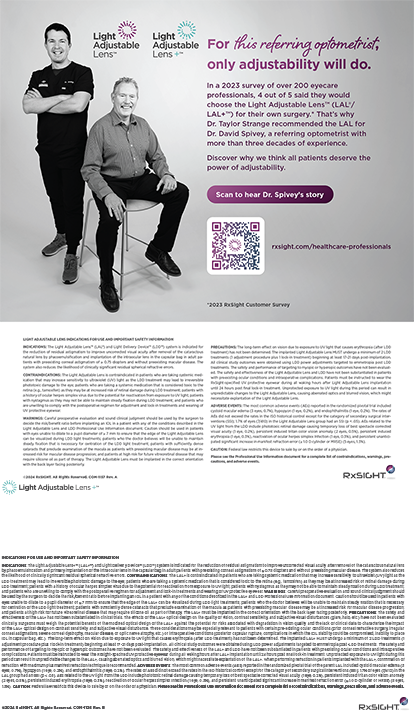Toxic anterior segment syndrome (TASS) is an acute, sterile, postoperative inflammatory reaction following anterior segment surgery. Among the multiple potential causes are issues with the cleaning and sterilization of instruments as well as problems with the fluids or medications used during surgery or during the immediate postoperative period. In early 2006, a large outbreak of TASS led to the establishment of a TASS task force by the American Society of Cataract and Refractive Surgery (ASCRS). The ASCRS TASS Task Force included ophthalmologists, nurses, members of industry, the FDA, and the Centers for Disease Control. This group held regular meetings and conference calls, and it published a review of the potential causes of TASS as well as recommendations for the cleaning and sterilization of ophthalmic instruments.1,2
At the ASCRS meeting in San Diego on April 27, 2007, the task force discussed a proactive initiative to improve the analysis of the potential causes of TASS. A letter to Kesia Alexander, PhD, at the FDA dated June 1, 2007, outlined that the ASCRS and I were interested in proceeding with a collaborative effort by the task force and the FDA. The task force met again at the ASCRS meeting in Chicago on April 4, 2008, to discuss the formation of a formal TASS Registry. The FDA provided funding to the Intermountain Ocular Research Center (IORC) at the University of Utah in Salt Lake City through a contract to collect data from previous analyses of TASS outbreaks as well as the data from the ASCRS, which were analyzed at the IORC. An institutional review board protocol at the University of Utah was developed for this purpose. In addition, funding was provided to help develop questionnaires to initiate a more proactive TASS program. The work on these new questionnaires was built on questionnaires previously developed by the ASCRS task force and the IORC. The contracts between the FDA and the University of Utah were done directly, because the test data from the ASCRS were analyzed and housed at the University of Utah. The ASCRS and the IORC then shared these data and original questionnaires with the FDA pursuant to a confidentiality agreement and was actively involved in the development of the next generation of questionnaires.
The proactive TASS Reporting and Surveillance program as well as the new questionnaires were developed and finalized during almost 3 years of collaboration between the ASCRS task force and the FDA group headed by Michelle Tarver, MD, PhD. A meeting of members of the ASCRS and FDA was held in Bethesda, Maryland, in January 2011 to discuss the project's timeline with the selected software vendor that would configure an electronic registry and to put the final agreements in place. In March 2011, while discussing the cooperative research and development agreement for the proactive TASS reporting program, much to the surprise of everyone from the ASCRS involved, the FDA claimed full ownership of the new questionnaires to the exclusion of the ASCRS and the IORC. Multiple attempts were made to work out an agreement between the ASCRS' lawyers and lawyers from the government. During these legal negotiations, the FDA not only claimed unlimited rights to the new, jointly developed registry questionnaires but also to all of the data that had been collected by the ASCRS and the IORC. The breakdown of the negotiations on the TASS registry led to the dissolution of the partnership between the IROC, the ASCRS, and the FDA and was deeply disconcerting to members of the task force who were involved in this process. After hundreds of hours of hard work on this project, the matter could not be resolved due to the intransigence of the FDA.
I was profoundly disappointed by the FDA's announcement of the proactive TASS program3 with absolutely no acknowledgement of the extensive involvement of the ASCRS task force and the IORC. The ASCRS TASS Task Force and the IORC continue to study the causes of TASS and to provide analyses and recommendations to surgeons and surgical centers that are having problems with TASS. This initiative continues to be carried out completely independently of the FDA's initiative through the financial support of the ASCRS.
Nick Mamalis, MD, is a professor of ophthalmology at the John A. Moran Eye Center of the University of Utah in Salt Lake City. He is cochairman of the ASCRS TASS Task Force and director of the IORC. Dr. Mamalis may be reached at (801) 581-6586; nick.mamalis@hsc.utah.edu.
- Mamalis N. Anatomy of a TASS outbreak. J Cataract Refract Surg. 2007;33:357-358.
- ASCRS Adhoc Task Force on cleaning and sterilization of intraocular instruments: recommended practices for cleaning and sterilizing intraocular surgical instruments. J Cataract Refract Surg. 2007;33:1095-1100.
- Eydelman MB, Tarver ME, Calogero D, et al. The Food and Drug Administration's proactive toxic anterior segment syndrome program. Ophthalmology. 2012;119:1297-1302.


